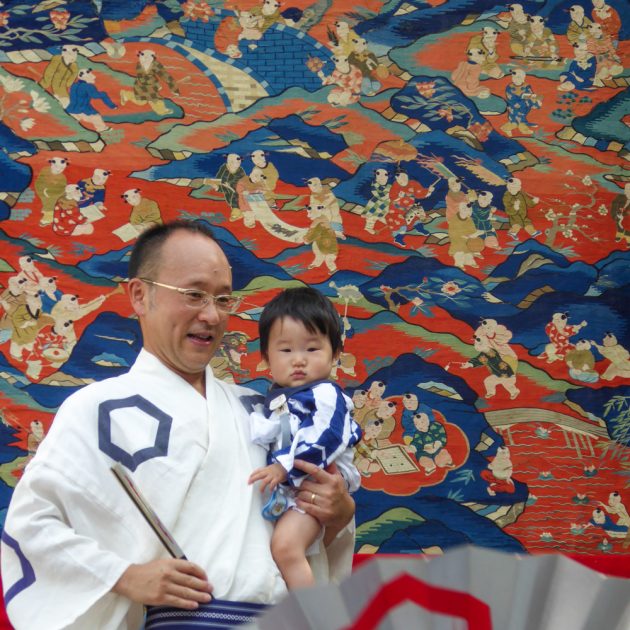
What do we humans do when things go terribly wrong? When disaster, illness and accompanying miseries persist, there’s a universal human sequence of responses: in turn we bear up, cope, stress, panic, and look for outer and inner causes to remedy. If the hardship continues, sooner or later we do something like pray. We reflect on transgressions we may have made, commit to improved behavior or view, and hope for absolution and relief. In other words, we turn to the spiritual realm.
In the year 869, amid floods, epidemics, and widespread deaths and other maladies from summer storms, Japan’s emperor did just that at the Ōike pond in Kyoto’s Imperial Palace grounds. He sponsored and took part in a goryō-e ritual, designed to appease whatever spirits had become so angry, to cause such suffering in the ancient capital.
We must surmise that the ritual worked, because it was repeated. Again and again. Over a nearly uninterrupted 1,150 years it morphed into Kyoto’s glorious and colossal Gion Festival. We could say it’s a global exemplar of sustainability.
And like many things we love so well––like historic Venice, or Kyoto temples in the colorful autumn season––we can love things so much and so unskillfully that we make them unbearable and unsustainable. Too many of us end up competing with one another to get what we want from the experience. It’s a model based on consumption and exclusivity. In Buddhist terms we’d say we’re trapped in greed, or in the illusion that there’s anything to “get.”
How can we change this predicament? How can we participate in the festival in such a way that we can gift it well to thousands of future generations? We’d do well to adopt a model that’s built on participation and inclusion. It’s mostly about changing our view.
For most of its history the inner world of the Gion Festival has been closed to outsiders. Changing times means this can no longer be the case. This presents Kyotoites with a unique window of opportunity to help support the shaping of one of the city’s main visitor attractions and revenue sources into something generative, vibrant and healthy. It’s a consummate creative group challenge.
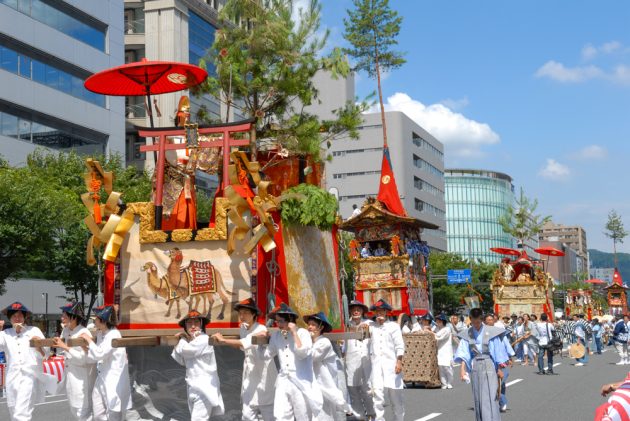
Firstly, let me tell you why I care. I fell in love with the Gion Festival in 1993, when I lived in the Kita Kannon Yama float’s chōnai neighborhood. I bumped into Kita Kannon Yama one morning outside my front door, and marveled up close several times a day as it was constructed, adorned, moved and taken down again.
Then it was gone. Like Japan’s celebrated sakura and samurai, it’s a study in mono-no-aware, the ceaseless creation-fruition-dissolution cycle of our lives, of existence itself.
I confess I initially got hooked by the Gion Festival’s worldly glamour: first the centuries-old exotic textiles, then the exquisite carvings, life-like metalwork, mystical statuary, and gilded paintings.
Over time, though, my passion has endured thanks to the countless people who dedicate so much of their life energy to keeping the Gion Festival going. Now I marvel at what dwells in their hearts more than at the material treasures. What compels people to contribute so much––freely or for relatively low financial compensation––with no thanks or recognition? Amidst oppressive crowds, heat, humidity, downpours and red tape?
Part of the beauty of the Gion Festival is that each person has a different reason. Some Gion Festival patrons are deeply committed to their community, or to the culture. Some are keen about the social and business opportunities, others to serving past and future generations.
A rare few speak openly with me about their commitment to the deities to whom the Gion Festival and its floats are dedicated. This is where it gets interesting.
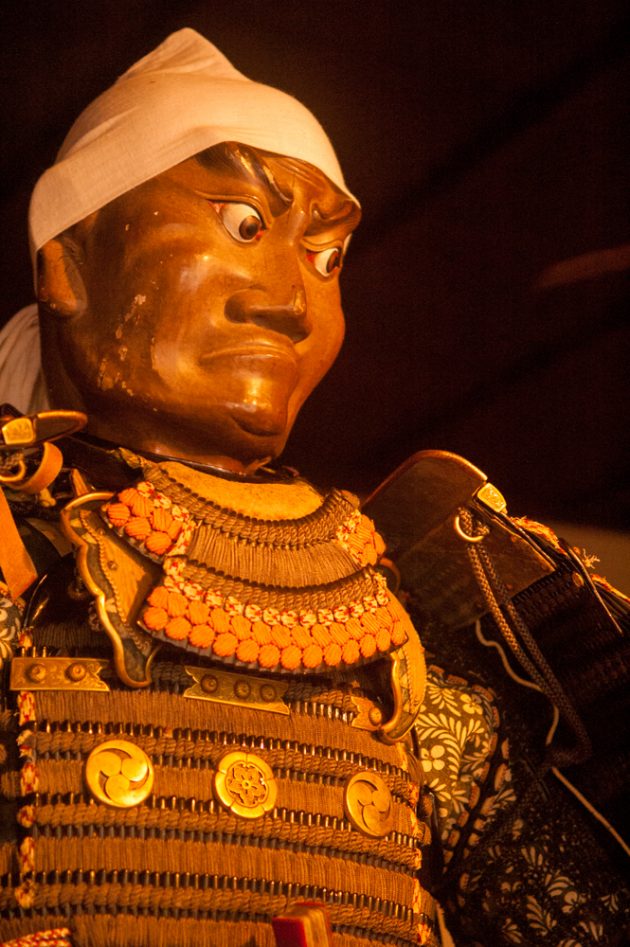
Susanō-no-mikoto is the Shintō god of storms, Japanese sun goddess Amaterasu-no-mikoto’s unpredictable, troublesome younger brother. It’s believed that epidemics are carried on the winds of storms, and that Susano has the power to bring plague, or prevent them. Over the Yasaka Shrine’s millennium of existence, Susanō-no-mikoto became conflated with Gozu Tennō, the ox-headed emperor, another protector against epidemics. The latter’s a manifestation of the Buddhist deity Yamantaka, ruler of epidemics and guardian of the threshold between life and death.
Scrolls with “Gozu Tennō” written on them are ubiquitous inside the Gion Festival floats’ display areas. Besides the mikoshi, Susanō-no-mikoto’s presence is less visible, though everyone knows he’s at the spiritual center of the immense Gion Festival. Though these deities are omnipresent, few people talk about them. Interestingly, the ones who have spoken to me about them seem to have the deepest commitment to––and the clearest vision for––the festival’s meaningful perpetuity.
With Susanō-no-mikoto, Kushi-Inada-hime and Gozu Tennō, we can discern how the original goryō-e ritual expanded from appeasing angry spirits causing floods and pestilence to enlist the support of other powerful beings.
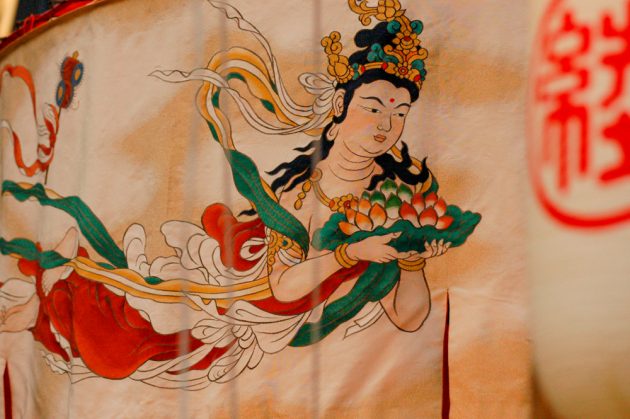
For years I reflected how the meaning of the Gion Festival had shifted, or even vanished entirely. After all, modern hygiene and engineering prevents the summer-borne illnesses that plagued Kyoto until the mid-20th century.
Then in July 2014 I launched my GionFestival.org website with the help of a talented team in the Philippines. Mid-launch, mid-Gion Festival, communications from them suddenly ceased. Later I learned that a severe typhoon struck, and they needed to look after their own physical safety. A few years later, just before the Gion Festival of July 2018, floods in Kyoto prefecture displaced thousands of people.
Has the uncertainty of climate change made the origins of the Gion Festival relevant again? Will the growth of extreme weather-related events make them even more pertinent for future generations? As politics and science fail to provide solutions, will we turn within and to entities that we cannot see?
In addition to the resident deities at Yasaka Jinja, every Gion Festival float has its own deity or deities as well. Over the centuries we can surmise that Gion Festival patrons added in whoever they felt would support greater balance in their corner of the human realm. In this sense the Gion Festival deities represent a kind of spiritual dream team for Kyoto, invoking values held dear: compassion, loyalty, courage, love, determination against the odds, and so on.
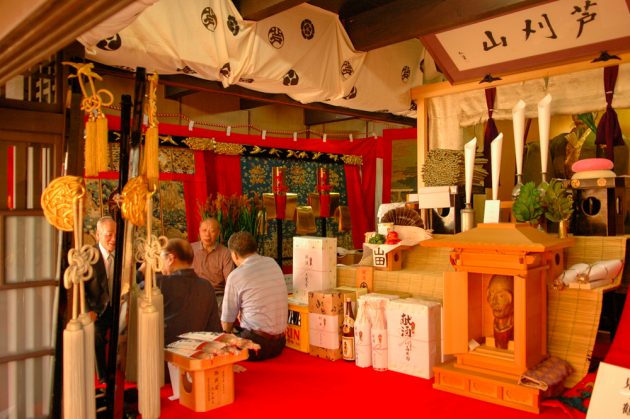
The Abura Tenjin Yama float chōnai believes that their neighborhood has been dedicated to their float’s Shintō deity––Tenjin, representing wisdom and forbearance––for at least a thousand years. How might that shape the character of a community? How could we measure that?
Out of the million annual visitors to the Gion Festival, the number with any sense of spiritual meaning in the Gion Festival must surely be very small. Gion Festival hands share anecdotes about how some visitors come for the outstanding people watching and awesome street food. Caught up in the worldly fun, some remain blissfully unaware that the festival features mikoshi and 33 spectacular floats, with respective deities and other cultural treasures.
Even those of us mesmerized by the enchanting artistic treasures and impressive history are still just looking at exquisite but essentially empty boxes. What does all this beautiful decorative wrapping contain, and why? It’s up to each visitor to answer that question for ourselves. That’s the profound meaning of the mirror at the heart of every Shintō shrine. Without such a question there’s no compelling reason to go through all the effort of keeping the festival going.
Thanks to their treasures, the Gion Festival floats have been famously referred to as “Moving Museums.” Like any museum, to stay vibrant the Gion Festival requires a quest, an investigation. Otherwise they risk becoming morgues of artifacts, meaningless to most people.
This is the Gion Festival’s multi-generational dilemma: tradition must be guarded and maintained, or else it’s not tradition. Worse, change threatens the stability that ensures the festival can continue to march into the future. However, too much protection makes any tradition stale and brittle, doomed to crumble to irrelevant pieces.
With so many people and moving parts, the Gion Festival is like a living organism, a spectacular self-organizing system. Adaptation to a changing environment is essential for vitality.
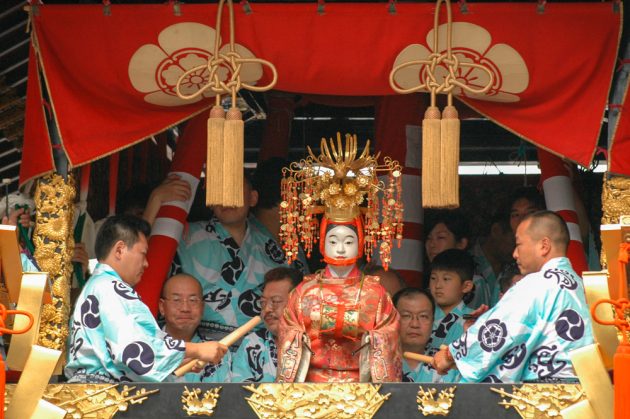
Who gets to determine how it goes? Amidst this era of unprecedented rapid change?
The Gion Festival operates thanks to Yasaka Shrine plus the 34 chōnai in central Kyoto, the historic epicenter of Japan’s kimono industry. Kimono merchants used the floats to flaunt their wealth, power and erudition.
Each chōnai consists of a discrete downtown neighborhood that each sponsors its own float. They’ve always had considerable autonomy over what they do. This allowed Kankō Boko to break with tradition in 1993 to allow women to participate in their float’s musical troupe, even though the Gion Festival has been men-only for centuries at least. This autonomous interconnectedness also meant that considerable resilience was built in to the Gion Festival: chōnai could support one another when required, and operate independently within the traditional form the rest of the time.
Municipal, prefectural and national government support like subsidies and grants is relatively new, dating from the 1960s. As the Gion Festival’s traditional economic base of the kimono industry has declined, and urban flight has emptied out downtown Kyoto of multi-generational historic residents, this government support has become indispensable for most floats.
In exchange the government now has some input into how the festival is organized and conducted. No precedent to this chōnai-government relationship exists, though, so it’s taking shape in real time. What changes that will herald for the heretofore fiercely independent chōnai generally remains to be seen.
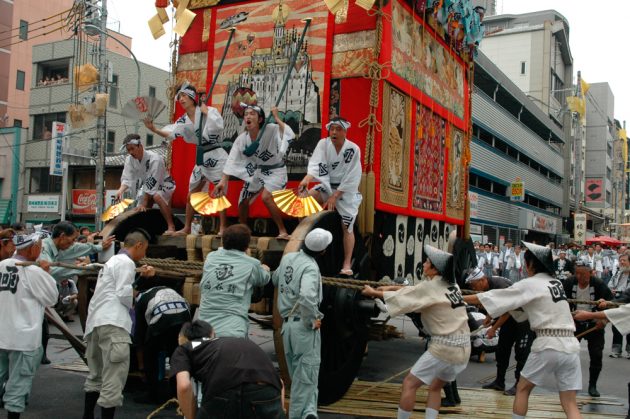
For a festival of its scope and history, there aren’t a lot of written resources on it in Japanese, much less in other languages. Most of what I’ve learned over 25 years of study has been from word of mouth. As a journalist this stressed me: how could I fact check? Over time I learned that quoting a respected festival elder is the most trusted reference.
Like many traditions around the world, the Gion Festival has been an oral culture until very recently. Oral transmission transcends time, weaving an invaluable intergenerational social fabric spanning past, present and future. Tradition was conveyed very naturally when families lived and worked in the same Gion Festival neighborhoods for many generations. We can still occasionally see three generations of son, father and grandfather walking together in the stately float processions on July 17 and 24.
Yet as downtown Kyoto’s real estate values go up, many historic families have sold their architectural treasures to apartment and hotel developers. These host visitors from out of town who, ironically, are keen to visit the heart of the Gion Festival. Unknowingly they contribute to the erosion of the community fabric that supports it.
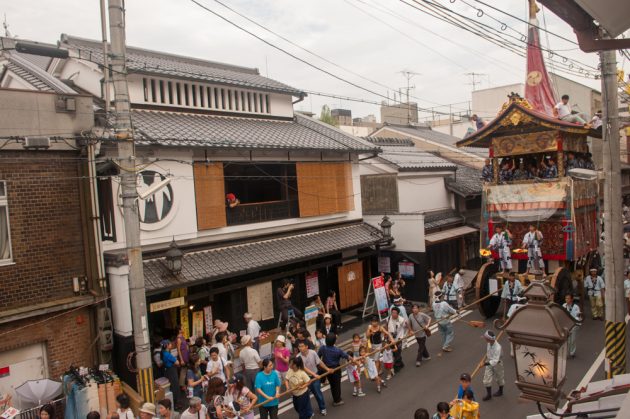
Awash in UNESCO World Heritage temples, Kyoto and Japan lag behind Europe in protection of historical and cultural cityscapes. Fortunately there is a considerable cityscape conservation movement in Kyoto, which continues to gain more traction. And the shifting community has opened up new social opportunities. Numerous Kyoto universities have formed relationships with Gion Festival floats, sending student volunteers as festival support teams. In some cases their activities comprise fieldwork for their degrees. As the festival neighborhoods’ residents turn over at historically unprecedented rates, contemporary, non-oral methods of conveying tradition to newcomers grow in importance.
The heroic efforts of historic residents who remain stalwart supporters of the festival shine brightly. They cheerfully steward the foundations of the festival amidst these times of rapid change. How can we support them? Sharing the best of the Gion Festival is my best effort. I’ve also started simply saying thank you to them. I can tell by the looks on their faces that this is a new thing for them too. And that they appreciate it.

Catherine Pawasarat has been going to the Gion Festival since 1990. She’s the author of an upcoming book, “The Gion Festival: Exploring Its Mysteries,” the first comprehensive guide in English. See GionFestival.org. After 20 years as a writer in Kyoto she now teaches spiritual awakening, Buddhism and meditation, and co-founded Clear Sky Retreat Center in the British Columbia Rockies, Canada, with her partner Doug Duncan. See also PlanetDharma.com.